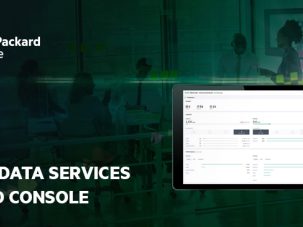From the 1940s through to the emergence of the internet, all data centres were on-premise. With the rise of the internet, technology and innovation has been rapidly developing and has brought forward a new era, where cloud addresses the limitations of traditional on-premise. With this came the advent and increased use of virtualisation, which continues to evolve and expand.
Today, businesses are adopting models that incorporate both on-premise and cloud-based data centres. However, unlike those early days, technology companies have applied their ingenuity to address previous constraints. These solutions have evolved to ensure IT infrastructure can adapt quickly to rapidly changing environments and supported by a data centre when appropriate for the business need.
As Aruba notes, "applying the old way of doing things to a new modern IT and cloud infrastructure can be a losing battle."
Product descriptors often include terms such as "compose" and "fabric". Below, we expand on these terms and clarify their meaning in the context of IT and data centre infrastructure and as they apply to Aruba and HPE solutions.
1. Data fabric
The term "fabric" refers to the architectural approach to data access or movement. Data fabric is an architecture that defines a set of data services, standardising data management practices across multiple cloud and on-premise environments, as well as edge devices. It aims to provide democratised data insights and visibility, equitable data access and control, and robust data protection and security. The benefits of this architecture include agility, efficiency, reduced bottlenecks, and speed.
A typical example of a data fabric is the HPE Ezmeral Data Fabric File and Object Store. The platform delivers a distributed data analytics solution across an entire organisation, irrespective of physical location.
2. Composable infrastructure
Composable infrastructure involves compute, storage, and networking resources being abstracted from their physical locations and managed by software through a web-based interface.
The many benefits of this architecture include:
- Making data centre resources available as cloud services
- Provisioning infrastructure as needed
- Logically pooling resources, minimising and over provisioning, increasing data centre agility and cost-effectiveness
- Facilitating Infrastructure-as-a-Service via a unified management interface
3. Aruba Fabric Composer
Aruba Fabric Composer is an intelligent, API-driven, software-defined orchestration solution that simplifies and accelerates network provisioning for virtual machines. It orchestrates a discrete set of switches as a single entity called a fabric, which significantly simplifies operations and troubleshooting. This data centre orchestration solution is fully infrastructure and application aware, providing automation of various configurations and lifecycle events.
It automates configuration and lifecycle events through its ability to orchestrate IT infrastructure using a discrete set of switches (i.e. 8000 series and 6300 switches). The net effect is a set of interactive and automated workflows, isolating and simplifying the complex data centre administrative functions.
Faster, more efficient data centre networking with Aruba Fabric Composer
A significant challenge in building and operating the modern enterprise data centre is efficient and effective network provisioning. Network infrastructure is traditionally complex and requires specialised skills and training to configure and manage. Network engineers and other resources are typically housed in a separate, siloed structure. Therefore, scheduling network maintenance or configuration can be time-consuming.
Aruba Fabric Composer provides a solution to this challenge in that it "simplifies and accelerates network provisioning, provides end to end visibility and automated detection of connectivity and performance issues.
Aruba Fabric Composer benefits
- Simplifies IT operations - Orchestrates switches under its control as a single fabric, with workflow automation and point and click GUI to streamline and automate complexity
- Accelerates Provisioning - Automates and simplifies configuration of virtual machines for optimal performance, removing the need to design and orchestrate the requisite connections within your environment
- Increased Visibility and Control - End to end network visibility of hosts, virtual machines, VLANs, services and workloads. Simplification of connectivity and performance problem troubleshooting. Automatically detects and dynamically resolves network issues before they impact your business.
- Unified Security Policy Configuration - Centrally defined policy elements distributed to every rack. Allows the easy configuration of stateless ACLs or stateful policies enforced by Distributed Services Firewalls
- Monitoring, Telemetry and Troubleshooting - Detailed alarms, events and deep insight as to what is going on in the network and security help with troubleshooting when issues arise.
In her article titled "Aruba Fabric Composer Unifies and Provisions Network and Security Policy Configurations," Silvia Fregoni states "simplifying enterprise data centre networks has been a major goal of Aruba Fabric Composer."
Support frictionless data access with HPE Ezmeral Data File and Object Store
HPE's Ezmeral Data File and Object Store is a platform designed to deliver an overarching, distributed data management solution, regardless of location. Its architecture is similar to woven fabric, where the individual strands are intermeshed, providing a unified, global view of the organisation's distributed data sources.
When a business grows and data is generated and stored in different locations and different formats, as defined by the unstructured data construct, customers can use HPE's Ezmeral Data File and Object Store to gather all data in a single platform (or framework), improving data access and usage regardless of how and where it is stored.
This Data Fabric breaks down multiple disparate data silos, allowing business data to be accessed in real-time as a unified data layer; simplifying machine learning and data analytics models and facilitating strategic decision-making across all levels of the organisation as the data insights generated are true, accurate, and consistent.
However, not all data is stored in a central location or data centre. There are many scenarios where data is generated and stored on Edge devices and at the edge of the cloud. Thus, customers need an improved way of managing this data without having to rip and replace it.
An ideal use case where this Data Fabric and Object Store platform comes into its own is where a company has data sources (such as databases storing app data) in the cloud and at the edge of the cloud. Edge data is typically generated by, but not limited to, IoT devices and network switches not physically located in the cloud or a geographically central location (such as company headquarters). This data can either be accessed, processed (or transformed) in situ, or uploaded into a centralised location such as a cloud data store. There are many reasons why ingesting the data into a data store, such as a Greenlake, is feasible in a particular scenario. It is preferable to analyse the data at its source.
A typical example would be a company that analyses weather data generated by weather stations situated across the globe. Most of this data can be uploaded to a centralised location before being analysed. However, there are instances where the real-time data must be analysed at the source, like an approaching severe weather event. There is too significant a time delay between when the data is generated and when it reaches the data store.
The HPE Ezmeral Data Fabric and Object Store is an ideal solution to the challenges of analysing data from multiple, widespread data sources.
In conclusion
Data movement within a data centre environment and access of the data itself is essential for operational and organisational success. Aruba, an HPE company, together with HPE themselves, have designed and continue to develop technology (hardware and software), ensuring that data centre operations are successful, and data is effectively accessed and processed, driving informed strategic decision-making.
Contact us, your IT partner, to explore how HPE and Aruba can assist in solutions that help you better manage your data, whether it resides in the data centre, in the cloud, or at the Edge.





